We may not have the course you’re looking for. If you enquire or give us a call on +852 2592 5349 and speak to our training experts, we may still be able to help with your training requirements.
Training Outcomes Within Your Budget!
We ensure quality, budget-alignment, and timely delivery by our expert instructors.
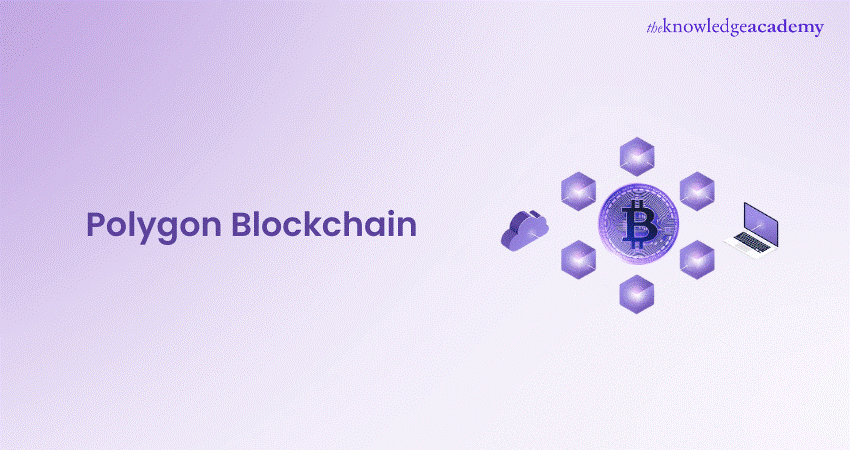
Imagine a world where Blockchain networks are cheaper, faster, and more seamlessly interconnected than ever! This is the world made possible by Polygon! Polygon Blockchain, or Matic Network (as known previously), goes beyond just a scalability solution—it’s a gateway to the next generation of Blockchain ecosystems. It is powered by its native token, MATIC, and is constantly reshaping how we interact with decentralised applications.
This blog goes deeper into the realm of Polygon Blockchain, its ability to solve scalability issues, working principles, and much more.
Table of Contents
1) History of Polygon (MATIC)
2) How Does Polygon Work?
3) Polygon vs MATIC: Key Differences
4) Key Features of Polygon Blockchain
5) Why is Polygon (MATIC) Good for Ethereum?
6) Polygon vs Ethereum: Key Differences
7) What is a Polygon Wallet?
8) Advantages and Disadvantages of Polygon
9) Future of Polygon (MATIC)
10) Conclusion
History of Polygon (MATIC)
Polygon, being a prominent Blockchain platform, is designed to address Ethereum's scalability issues. It was founded by Jaynti Kanani, Sandeep Nailwal, Anurag Arjun, and Mihailo Bjelic. Since then, significant evolution has occurred in Polygon. Here is a timeline to highlight the key events in the history of Polygon (MATIC):
1) 2017: Polygon was originally launched as Matic Network by software engineers Jaynti Kanani, Sandeep Nailwal, Anurag Arjun, and Mihailo Bjelic.
2) February 2021: Matic Network was rebranded as Polygon Technology.
3) August 2021: A few months later, Polygon acquired Hermez Network for $250 million (roughly £198 million).
4) December 2021: In December, Polygon acquired the Mir Blockchain network for 250 million MATIC tokens, which was valued at approximately $400 million (roughly £317 million) at that time.
5) October 2023: Soon, Polygon announced a major upgrade to transition its native token from MATIC to POL.
6) September 4, 2024: The token got its transition from MATIC to POL which became effective.
How Does Polygon Works?
Polygon serves as a crucial platform to build an interconnected Blockchains network. Here is a detailed look at the working of Polygon:
1) Interconnected Blockchains Network: Polygon builds an interconnected Blockchain network that utilise sidechaining to resolve scalability issues. It runs parallel to the main Ethereum (ETH) architecture, which allows assets to be transferred to the sidechain from the mainchain whenever needed.
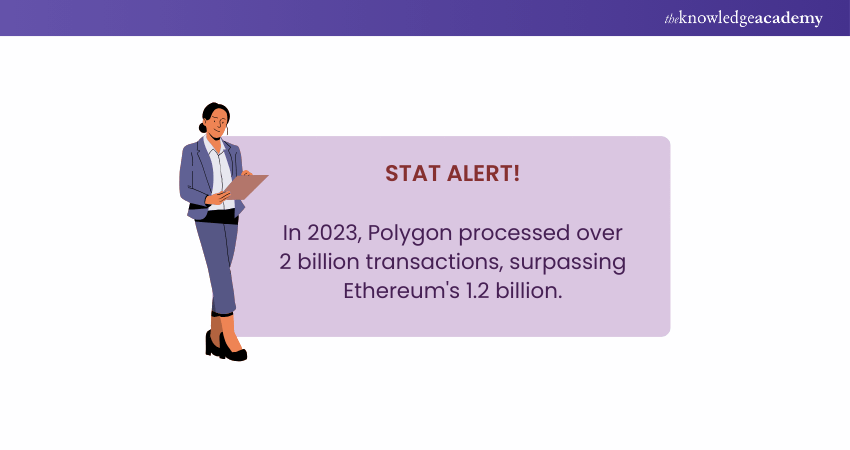
2) Proof-of-Stake (PoS) Approach: The Proof-of-Stake (PoS) Polygon operates as a sidechain that uses the Proof-of-Stake (PoS) approach to determine which user can validate or mine a block. This contrasts with the Proof-of-Work (PoW) approach, where complex mathematical problems are solved by every node in the Blockchain network.
3) Heimdall Architecture: Polygon employs the Heimdall architecture for the random selection of block producers. This architecture ensures the security and scalability of the network. Polygon validators run parallel to Ethereum’s mainchain and regularly validate all transactions to maintain network consistency.
Want to become familiar with Cryptocurrency trading and Blockchain technology- Join Cryptocurrency Trading Training now.
Polygon vs MATIC: Key Differences
Polygon and MATIC, though often used interchangeably, have distinct differences. Here are some key points to understand their relationship and functionalities:
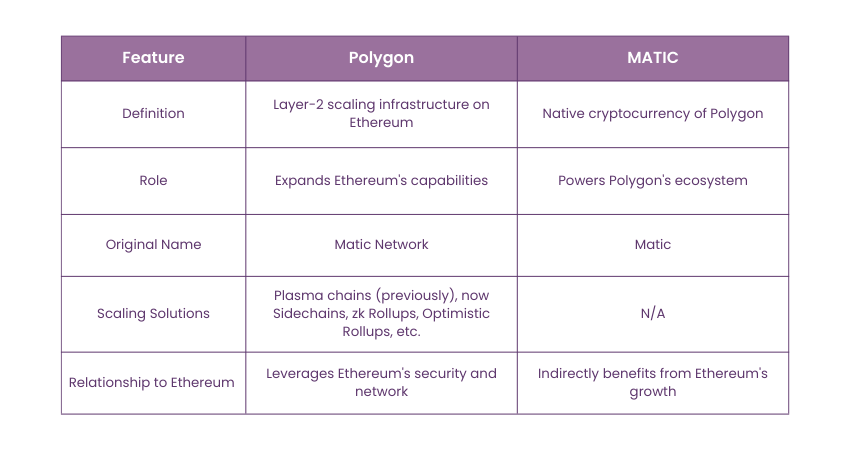
1) Definition
Polygon: Polygon is a Layer-2 scaling infrastructure that exists on the Ethereum Blockchain, initially launched as Matic Network in 2019.
MATIC: The native token of the Polygon ecosystem, used to power the Blockchain.
2) Role
Polygon: It enhances Ethereum's scalability by providing a framework for building interconnected Blockchains, initially using Plasma chains and later adopting sidechains.
MATIC: It serves as the utility token within the Polygon network to facilitate transactions and governance.
3) Original Name
Polygon: It was originally launched as Matic Network in 2019.
MATIC: It is always known by the name MATIC, even after the network rebranding.
4) Scaling Solutions
Polygon: Polygon utilises various scaling solutions. Initially it was Plasma chains, and later it was side chained by zk Rollups, and Optimistic Rollups, to enhance scalability.
MATIC: MATIC supports these scaling solutions by serving as the token used in transactions and network staking.
5) Relationship to Ethereum
Polygon: It acts as a Layer-2 scaling infrastructure on the Ethereum Blockchain. This helps to address Ethereum's limitations, such as high transaction fees and slow processing speeds.
MATIC: It is powered by the Polygon ecosystem to facilitate transactions and governance. This contributes to the overall efficiency and scalability of the Ethereum network.
Learn how Bitcoins work and how are Bitcoins made secured by joining Bitcoin and Cryptocurrency Course.
Key Features of Polygon Blockchain
Polygon is among the leading Layer-2 competitors for several reasons. Here are four main features that make Polygon distinct from others:
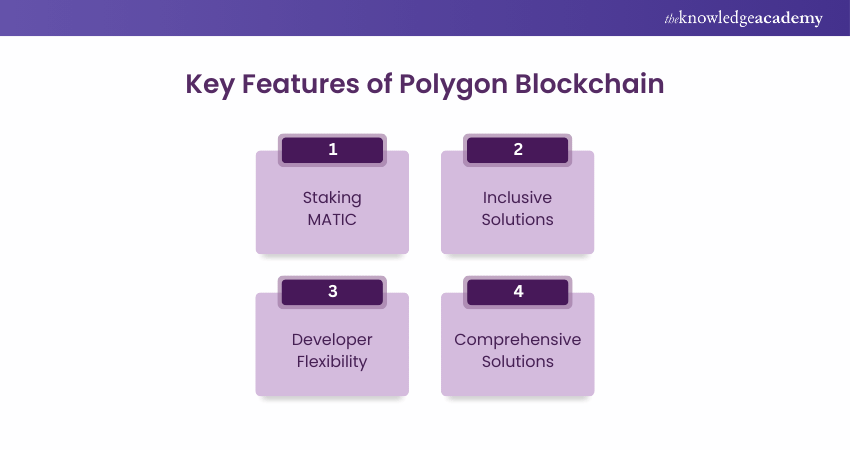
1) Staking MATIC: One of the distinctive features of Polygon is it allows MATIC, its native Cryptocurrency, to be staked on its Blockchain. This is distinct in Polygon and sets it apart from other networks.
2) Inclusive Solutions: Polygon was designed to provide solutions for everyone, including users and enterprises, not just developers. Its ultimate aim is to scale Ethereum to one billion users without compromising security, with a goal of creating an Internet of Things (IoT) for the Ethereum Blockchain.
3) Developer Flexibility: Another special feature of Polygon is the flexibility it offers developers. They can choose between zk rollups or optimistic rollups and also have the option of using Polygon Avail for secure data availability.
4) Comprehensive Solutions: Polygon provides a range of solutions on a single network for developers. This allows them to make better choices regarding the scaling solution for their applications, enhancing the overall efficiency and effectiveness of their projects.
Learn to use managed Blockchain networks quickly using AWS CLI and AWS Management Console. Sign up for our Amazon Managed Blockchain Training today!
Why is Polygon (MATIC) Good for Ethereum?
A key aspect often neglected about Polygon and Ethereum is their interdependence. Here are some important points to consider:
1) Interdependence: Ethereum and Polygon are both interdependent on each other, with Polygon’s mission focused majorly on developing infrastructure and systems to manage Ethereum’s mass adoption.
2) Growth of Ethereum Users: As Polygon enhances Ethereum's capabilities, the user quantity on the Ethereum Blockchain is expected to grow. This user increase leads to a rise in the value of Ethereum as more people invest their capital in Blockchain.
3) Enhanced Scalability: Polygon ensures smoother and more efficient operations by reducing congestion and lowering transaction costs on Ethereum. This scalability enhances Ethereum's usability for a broader range of applications.
Polygon vs. Ethereum: Key Differences
Polygon and Ethereum are both prominent Blockchain platforms, but they differ significantly in terms of features and functionality. Here are the key differences between the two:
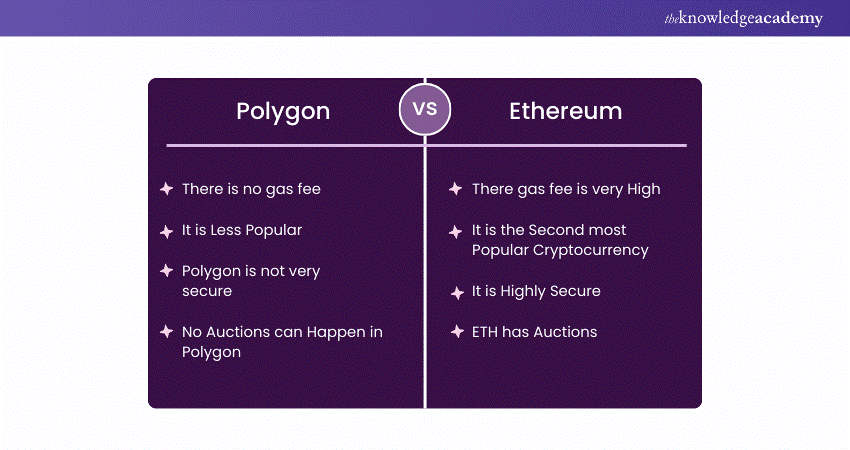
1) Gas Fees: Polygon does not charge gas fees for transactions. In contrast, Ethereum incurs very high gas fees in a few instances.
2) Popularity: Polygon is less popular compared to Ethereum and vice-versa.
3) Security: Polygon is considered less secure, while Ethereum is widely regarded as highly secure for transactions and operations.
4) Auctions: Polygon does not support auctions, while Ethereum allows auctions to take place on its platform.
Gain insights into the Cryptography and Bitcoin core concepts- register for our Blockchain Course today!
What is a Polygon Wallet?
Polygon Wallet is among the key tools that enable users to navigate the Polygon network easily. It helps users send and receive Crypto Assets, as well as deposit and withdraw between Blockchains, by providing access to the Polygon bridge. Additionally, users can stake MATIC on the network through the Polygon wallet.
A key benefit of the Polygon network is its non-custodial web wallets, which let users manage their tokens and control their private keys. However, MATIC can also be stored in any ERC-20-compatible wallet.
Advantages and Disadvantages of Polygon
Polygon is a popular Blockchain platform known for its speed and cost-efficiency, but like any technology, it has its own sets of strengths and limitations. Below are the key advantages and disadvantages of using Polygon:
Advantages:
1) It offers faster transaction speeds
2) Its interoperability with other Blockchain networks is a huge advantage
3) High transaction speeds
4) Lower cost than on Ethereum
5) Ability to stake Matic to earn rewards from network security
6) Increased flexibility, scalability, and sovereignty of a Blockchain project
Disadvantages:
1) It offers only partial transparency
2) Upgrading the Polygon network can be a challenge
3) Lack of direct incentives for users
4) Smaller validator set increases the risk of potential attacks
5) Limited validators raise concerns about centralisation within Polygon Blockchain
6) Dependence on Ethereum
This table summarises the benefits and drawbacks of Polygon Blockchain
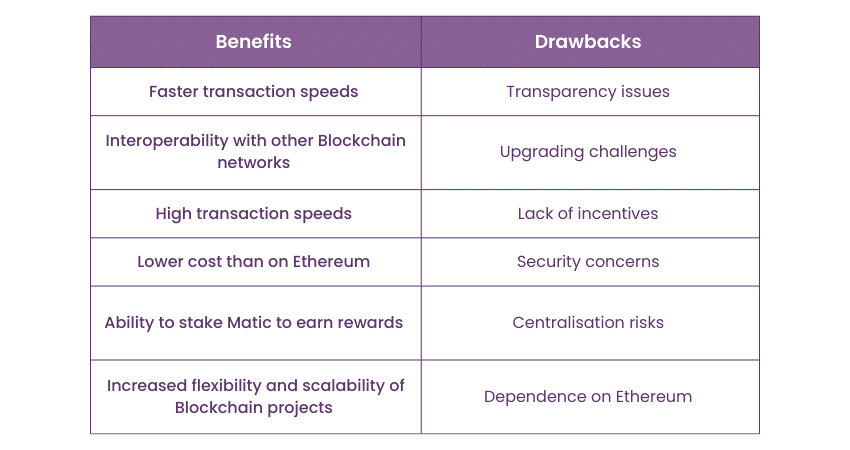
Future of Polygon (MATIC)
The future of Polygon (MATIC) looks promising given its current growth trajectory. Here are some key points which highlights its potential:
1) Secure Future: With its rapid growth, Polygon's future appears secure. The platform continues to enhance its capabilities and user base, reinforcing its position in the Blockchain ecosystem.
2) Polygon Studios: Launched in 2021, Polygon Studios is a branch of Polygon focused on gaming and non-fungible tokens (NFTs). This addition has significantly contributed to Polygon's growth and its appeal to developers and users in the gaming and NFT sectors.
3) Decentralised Gaming and NFTs: The success of Polygon Studios is a powerful factor in positioning Polygon as a prominent technology provider for decentralised gaming and NFTs. This success is expected to drive further adoption and innovation within the Polygon ecosystem.
Conclusion
In conclusion, the Polygon Blockchain is a scalable solution that elevates Ethereum’s performance with faster transactions and lower costs. Through cutting-edge features like multi-chain support and flexibility for developers, Polygon can drive the adoption of decentralised applications, making it a key player in the rapidly-evolving Blockchain ecosystem. As the Blockchain landscape continues to innovate, Polygon paves the way for a more accessible and efficient digital future.
Master the craft of Ethereum Development by signing up for our Ethereum Developer Course.
Frequently Asked Questions

Polygon (MATIC) offers scalability, low costs, and interoperability, making it appealing for blockchain enthusiasts. However, its success depends on market trends, adoption, and competition. Always assess your risk tolerance and research thoroughly before investing.

Yes, Polygon is built to work alongside Ethereum. It's a Layer 2 scaling solution to enhance Ethereum's functionality by providing faster and cheaper transactions while leveraging Ethereum's security and ecosystem. However, it operates independently with its own Blockchain network.

The Knowledge Academy takes global learning to new heights, offering over 30,000 online courses across 490+ locations in 220 countries. This expansive reach ensures accessibility and convenience for learners worldwide.
Alongside our diverse Online Course Catalogue, encompassing 19 major categories, we go the extra mile by providing a plethora of free educational Online Resources like News updates, Blogs, videos, webinars, and interview questions. Tailoring learning experiences further, professionals can maximise value with customisable Course Bundles of TKA.

The Knowledge Academy’s Knowledge Pass, a prepaid voucher, adds another layer of flexibility, allowing course bookings over a 12-month period. Join us on a journey where education knows no bounds.

The Knowledge Academy offers various Blockchain Courses, including the Bitcoin and Cryptocurrency Course and the Ethereum Developer Course. These courses cater to different skill levels, providing comprehensive insights into the Pros and Cons of Cryptocurrency.
Our Advanced Technology Blogs cover a range of topics related to Blockchain Technology, offering valuable resources, best practices, and industry insights. Whether you are a beginner or looking to advance your Blockchain knowledge skills, The Knowledge Academy's diverse courses and informative blogs have got you covered.
Upcoming Programming & DevOps Resources Batches & Dates
Date
 Blockchain Training Course
Blockchain Training Course
Thu 16th Jan 2025
Thu 6th Mar 2025
Thu 22nd May 2025
Thu 24th Jul 2025
Thu 4th Sep 2025
Thu 11th Dec 2025







 Top Rated Course
Top Rated Course



 If you wish to make any changes to your course, please
If you wish to make any changes to your course, please


